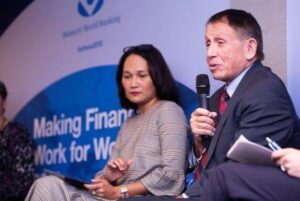The opening Plenary Session at the Making Finance Work for Women Summit discussed the progress and the opportunities ahead in financially empowering low-income women in the developing world. Four key themes emerged: the role of digital, policy design, a broader tent, and leadership skills are necessary to make finance work for women.
Kicking off the opening plenary session from the Making Finance Work for Women 2018 summit, President and CEO, Mary Ellen Iskenderian challenged the audience with some sobering statistics. Despite seeing progress in building assets and resources for women, there are still 104 countries that have laws precluding women from working in certain jobs. The gender gap in the developing world still has not budged from a stubborn 9 percent over the last three years. The gender gap has even widened (doubled in some cases!) in certain countries, such as Nigeria and Bangladesh. And in India where the gender gap has been dramatically reduced, financial service providers are being challenged by 48 percent dormancy rates for savings accounts, one of the highest rates in the world.

The panelists debating this topic included: Sarah Kaplan, Director of the Institute for Gender and the Economy, and Professor of Strategic Management at Rotman School of Management; Liz Kellison, Gender Lead for the Financial Services for the Poor team, Bill & Melinda Gates Foundation; Mike Useem, Director of the Center for Leadership and Change Management, and Professor of Management at the Wharton School; and Sri Widowati (Wido), Country Director (Indonesia), Facebook.
Digital Opens Doors to Gender Equality Opportunities
Widowati discussed the role of digital as a great gender equalizer. It provides women with access to new ideas, opportunities, customers, and markets. Additionally, women can enjoy this access from the comfort of their own homes. Digital platforms, such as Facebook, are creating new channels for women to reach (and even create) new markets. Women can also access knowledge and networks through social platforms to help them set up, run, and grow their businesses. Digital literacy is key to ensuring widespread participation.
Kellison mentioned that the Gates Foundation believes that digital payment systems are an effective way to reach low-income populations at scale. The Foundation sees great promise in digitizing government-to-person (G2P) social safety net payments as a way to onboard more women to adopt and use digital financial services. Since the vast majority of the G2P cash transfer recipients are women, this is a great way to leverage an existing channel to effectively target women.
Enlisting Support from Regulators
Another key to achieving financial inclusion is to engage regulators to help create the right inclusive enabling environment. Kellison mentioned that one-third of the Financial Services for the Poor team is focused on how regulation can be evolved to enable gender equality. Tiered accounts, eKYC, flexible identification requirements, and alternative credit scoring methodologies are some of the recent developments in the industry that have allowed for greater access by women. To this end, Women’s World Banking and AFI are partnering to deliver a Leadership and Diversity program for Regulators (funded by the Visa Foundation). The program aims to drive greater gender diversity within regulatory bodies, as well as accelerate strategic policy initiatives to more effectively close the gender gap.
Pushing for Progress
Beyond the opportunities presented by digital and policy initiatives, the panelists discussed how else the sector might push for progress. Useem discussed the need for leaders to think strategically, communicate persuasively, and take action decisively. He used the image of a coalition of the eager and ready. Kaplan added that innovation needs to be brought into the conversation. By working under incorrect assumptions, such as women are risk-averse or do not know how to ask, women are still limited by the current system structure. She urged participants to look where interventions are breaking down, and then apply gender analysis; fixing the system to take women into consideration will also help men. Fighting for gender equality needs to make life better for everyone.
Kaplan also suggested that until now, the industry has been designing for low-income women; providers need to design with women for true progress. Some of the negative unintended consequences of interventions have resulted because the women were not sufficiently brought into the conversation.
One of the male attendees asked how to get more men involved (the room was approximately 80 percent female). A passionate discussion ensued about whether the business case for serving women should be the way to bring men into the room. A McKinsey Global Institute report finds that $12 trillion could be added to global GDP by 2025 by advancing women’s equality. While the business case is certainly compelling, it must be supplemented by moral outrage at the gender inequality that still exists. Kaplan suggested that if it’s just the business case that brings financial service providers to the table, women customers can feel on the outside. The business case must be carried by the vision of serving women as valuable customers so that everyone wins.




